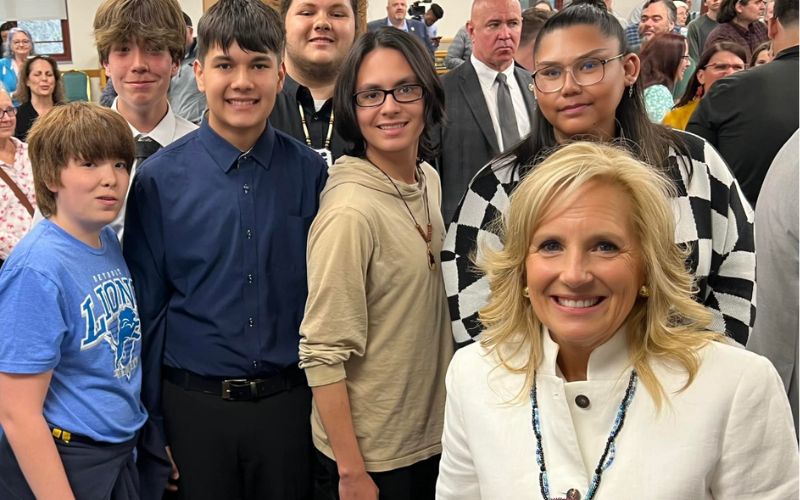
- Details
- By Levi Rickert
Before becoming the assistant secretary for Indian Affairs, Bryan Newland (Bay Mills Indian Community) served as the president of the Bay Mills Indian Community. On Thursday, he was home to greet First Lady Jill Biden and Second Gentleman Douglas Emhoff to his tribal community in Brimley, Michigan, along the shores of Lake Superior in Michigan’s Upper Peninsula.
Newland served as the emcee for a community event attended by the first lady and second gentleman of the United States at Bay Mills Community College on Thursday evening. Current Bay Mills Indian Community President Whitney Gravelle and Sault Ste. Tribal Chairperson Austin Lowes also participated in the event’s program.
As first lady, Dr. Biden has made more trips to Indian Country — more than seven — to Indian Country. No other first lady in history has visited as many tribal leaders and tribal communities.
Newland mentioned this in his opening remarks.
"This is the fourth time I've had the opportunity to travel with First Lady Dr. Biden to tribal communities,” Newland said. “These visits, as many of you know, are not the norm in our country's history. Dr. Biden and her team seek out these opportunities because she understands the importance of showing up and walking the walk."
President Joe Biden mentioned Dr. Biden’s visits to Indian Country in his White House Tribal Nation Summit address to tribal leaders in November 2022. After mentioning First Lady Biden and Interior Secretary Deb Haaland’s visit to the Cherokee Nation, the president mentioned she had visited other tribal nations.
“By the way, she spent a lot of time on other reservations — other Nations as well. I’m worried she’s not going to come home one of these days,” Biden joked to tribal leaders who received his remarks with laughter.
On Thursday, she and Emhoff visited Bay Mills to tout Biden-Harris's “Investing in America” agenda, which has injected $45 billion into Indian Country in the last three years. In her speech, Biden spoke of the president’s signing a historic executive order honoring the Nation-to-Nation relationship and supporting Tribal self-determination.
“He's begun an unprecedented collaboration with Tribal Nations to manage the lands, waters, and natural wonders,” Biden said.
The second gentleman also spoke about the Biden-Harris administration’s commitment to Indian Country.
“When President Biden and Vice President Harris took office, they acknowledged the duty to safeguard and strengthen the bonds between our nations,” Emhoff said. “They also vowed to build a future in which every Native person can realize their aspirations and every Native community can be a place of opportunity. That is why President Biden and Vice President Harris have invested nearly $45 billion in Indian Country.”
Speaking about showing up, the first lady said:
“You show up for each other – and for your communities – and the president and I want to show up for you. Joe made a commitment to Indian Country – and he’s delivering on his promises. It has been one of my greatest honors to travel to Indian Country as First Lady.”
Biden’s other visit to a Michigan tribe occurred on October 23, 2022 when she visited the Saginaw Chippewa Tribe on the Isabella Indian Reservation in Mt. Pleasant, Michigan. She and Emhott will follow Thursday's visit to Bay Mills with a visit to
The nearby community of the Sault Ste. Marie Tribe on Friday.
More Stories Like This
Native News Weekly (August 25, 2024): D.C. BriefsUS Presidents in Their Own Words Concerning American Indians
Ethics Complaint Alleges Former Navajo Nation Chief of Staff Accepted Gifts From Contractor
Monday Morning (December 14, 2025): Articles You May Have Missed This Past Weekend
Senators Demand Accountability Amid Reports of ICE Questioning Native Americans
Help us defend tribal sovereignty.
At Native News Online, our mission is rooted in telling the stories that strengthen sovereignty and uplift Indigenous voices — not just at year’s end, but every single day.
Because of your generosity last year, we were able to keep our reporters on the ground in tribal communities, at national gatherings and in the halls of Congress — covering the issues that matter most to Indian Country: sovereignty, culture, education, health and economic opportunity.
That support sustained us through a tough year in 2025. Now, as we look to the year ahead, we need your help right now to ensure warrior journalism remains strong — reporting that defends tribal sovereignty, amplifies Native truth, and holds power accountable.
 The stakes couldn't be higher. Your support keeps Native voices heard, Native stories told and Native sovereignty defended.
The stakes couldn't be higher. Your support keeps Native voices heard, Native stories told and Native sovereignty defended.
Stand with Warrior Journalism today.
Levi Rickert (Potawatomi), Editor & Publisher


